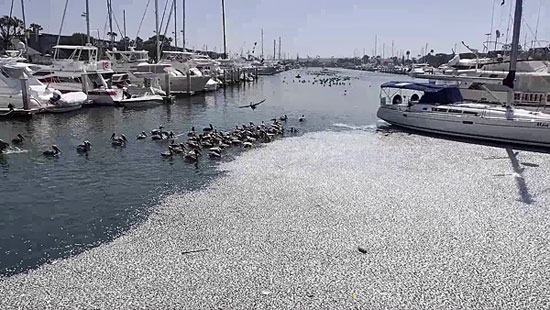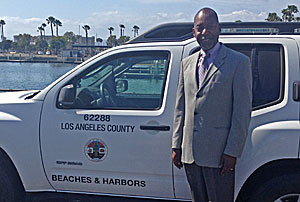
L.A. County crews hauled tons of anchovies and sardines out of the marina, with help from the pelicans.
You could see in the sky that something was fishy.
On Sunday, hundreds of pelicans were dive-bombing the waters of Marina del Rey, while swarms of screaming gulls circled overhead. “It was like a scene out of Hitchcock,” recalled Kenneth Foreman of the Los Angeles County Department of Beaches and Harbors.
But unlike the film version, these frenzied birds (and legions of gluttonous sea lions) were gorging themselves on a spread of anchovies and sardines—a very big, stinky spread. For reasons still unclear, the tiny fish had found their way into a corner of the marina, where they depleted the oxygen and suffocated.
As division chief of the agency’s facilities and property maintenance section, it was Foreman’s job to get rid of the silvery mess that had boaters and residents crying foul.
By late Sunday afternoon, less than a day after the fish surfaced en masse, Foreman’s crews had removed an estimated 6 tons of them. “Our guys did a great job in a short period of time,” said Foreman, a 30-year veteran of the department. For the record, he said, the fish carcasses weren’t placed in a shallow, sandy grave. They were transported by a disposal company to Victorville, where they’ll be converted into compost “so that some beneficial use can come of this.”
The media frenzy that surrounded the weekend die-off and clean-up offered a rare moment in the sun for Foreman’s operation. Away from the glare, his crew tackles everything from cleaning the county’s 51 beach bathrooms to stringing nets on 292 volleyball courts to alerting authorities to the occasional pre-dawn discovery of dead bodies on the sand—some of them apparent suicides.
“I guess the beach was the last thing they wanted to see,” said Foreman, whose 157 employees are also responsible for 1,169 trees, 8.5 miles of sand berms, 4,700 boat slips and 8,161 beach parking stalls.
Every year, between 50 to 60 million visitors flock to the 61 miles of beaches maintained and operated by Los Angeles County. That’s more than all the national parks combined, according to Foreman’s boss at Beaches and Harbors, Deputy Director John Kelly. He said the maintenance division, which has collected 84,000 tons of trash during the past two decades, prides itself on getting the beaches and their restrooms ready before daybreak, unlike some other jurisdictions.
In the early morning, he said, “Santa Monica [beach] parking lots are strewn with trash. You pass by the county beaches, they’re already clean.”
But Foreman’s crews also tackle many less predictable duties that don’t get public notice or end up on the division’s stat sheet.
Foreman said, for example, that in recent years the department increasingly has been called on to help law enforcement authorities deal with “panga” boats abandoned on the sand by drug dealers or illegal immigrants trying to come ashore. The last incident, he said, occurred near Manhattan Beach and led to the arrest of 20 people allegedly trying to enter the country illegally.
More often, however, the department is dispatched to get rid of old, unseaworthy boats that have broken free of makeshift moorings and ended up shipwrecked on the sand.
Sometimes, the division confronts ocean creatures very different from those tiny specimens it encountered over the weekend. It’s not unusual, Foreman said, for dead sea lions, dolphins or whales to wash up on the county’s beaches, as two did in 2012. “Ideally,” he said, “we try to tow them out to sea so Mother Nature can take care of them.” But if it looks like the tide might push them back to shore, “then we try to bury them in the sand.”
“In this department,” he added, “we’ve seen it all. There’s never an opportunity to get bored. Something new and different is going to occur, guaranteed.”
Posted 5/22/14







